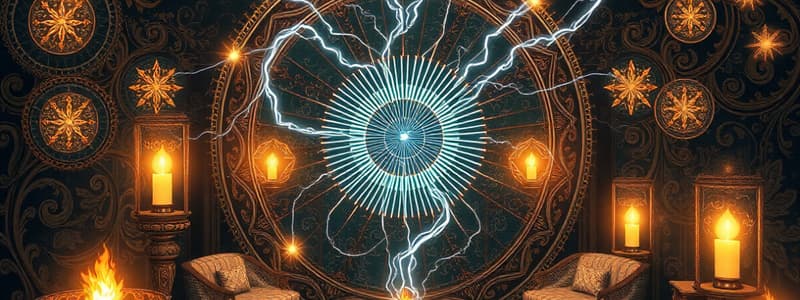Podcast
Questions and Answers
What should be included when making observations?
What should be included when making observations?
- Personal opinions
- Interpretations and models (correct)
- Historical examples
- Only raw data
Which statement about electricity is accurate?
Which statement about electricity is accurate?
- Electricity does not exist in nature.
- Electricity is a naturally occurring force that surrounds us. (correct)
- Electricity is a force that is always visible.
- Electricity can only be generated artificially.
Why is it important to build models when making observations?
Why is it important to build models when making observations?
- To minimize the need for data collection.
- To help in predicting how things will behave. (correct)
- To avoid interpretations altogether.
- To replace direct observation completely.
What is a key characteristic of electricity?
What is a key characteristic of electricity?
When should models be built in the observational process?
When should models be built in the observational process?
What is the phenomenon called when positive and negative charges separate in a body due to a nearby charged object?
What is the phenomenon called when positive and negative charges separate in a body due to a nearby charged object?
What term is used for the charge that appears on a conductor as a result of electrostatic induction?
What term is used for the charge that appears on a conductor as a result of electrostatic induction?
Which of the following best describes induced charge?
Which of the following best describes induced charge?
In the context of electrostatic induction, which of the following statements is true?
In the context of electrostatic induction, which of the following statements is true?
What occurs first in the described experiment with the two uncharged metal spheres?
What occurs first in the described experiment with the two uncharged metal spheres?
Which of the following scenarios best exemplifies electrostatic induction?
Which of the following scenarios best exemplifies electrostatic induction?
Why are the metal spheres placed on insulating stands?
Why are the metal spheres placed on insulating stands?
What is the main purpose of touching the two uncharged metal spheres together?
What is the main purpose of touching the two uncharged metal spheres together?
What effect will touching the two spheres have on their charges?
What effect will touching the two spheres have on their charges?
If the spheres were separated after being touched, what would be the charge state of each sphere?
If the spheres were separated after being touched, what would be the charge state of each sphere?
What is the main function of an electroscope?
What is the main function of an electroscope?
Which part of an electroscope is crucial for detecting charge?
Which part of an electroscope is crucial for detecting charge?
How can an electroscope be used to determine the sign of a charge?
How can an electroscope be used to determine the sign of a charge?
What would happen to the metal leaves of a charged electroscope when a similarly charged object is brought close?
What would happen to the metal leaves of a charged electroscope when a similarly charged object is brought close?
Which of the following correctly describes how to determine the relative magnitude of charge using an electroscope?
Which of the following correctly describes how to determine the relative magnitude of charge using an electroscope?
What happens to the powder particles when they lose their positive charge?
What happens to the powder particles when they lose their positive charge?
What is the resulting behavior of powder particles that acquire a negative charge?
What is the resulting behavior of powder particles that acquire a negative charge?
Which statement best describes the change in charge of the powder particles?
Which statement best describes the change in charge of the powder particles?
What is the immediate consequence of powder particles acquiring a negative charge?
What is the immediate consequence of powder particles acquiring a negative charge?
What type of charge do powder particles have before the described change occurs?
What type of charge do powder particles have before the described change occurs?
Study Notes
Key Concepts of Observation and Electricity
- Observations should include interpretations and model building to predict behavioral patterns.
- Electricity is a ubiquitous natural force.
Experiment 1: Induction and Separation
- Two uncharged metal spheres are placed on insulating stands and allowed to touch each other initially.
- Electrostatic induction occurs when a charged object influences the distribution of charges within a nearby conductor, causing a separation of positive and negative charges.
- The charges that develop on each conductor are referred to as induced charges.
Electroscope Usage
- Students should understand how to illustrate a simplified diagram of an electroscope.
- An electroscope can be used to detect:
- The presence of an electric charge.
- The type of charge (positive or negative).
- The relative magnitude of the charge.
Charge Behavior in Experiment
- Powder particles near the charged object lose their positive charge and acquire a negative charge.
- The negatively charged particles are then repelled back to the bottom plate of the setup.
Studying That Suits You
Use AI to generate personalized quizzes and flashcards to suit your learning preferences.
Related Documents
Description
This quiz delves into the fundamental principles of observation in electricity, focusing on electrostatic induction and charge behavior. Students will also learn how to utilize electroscopes to detect and measure electric charges effectively. Test your understanding of these critical concepts!




